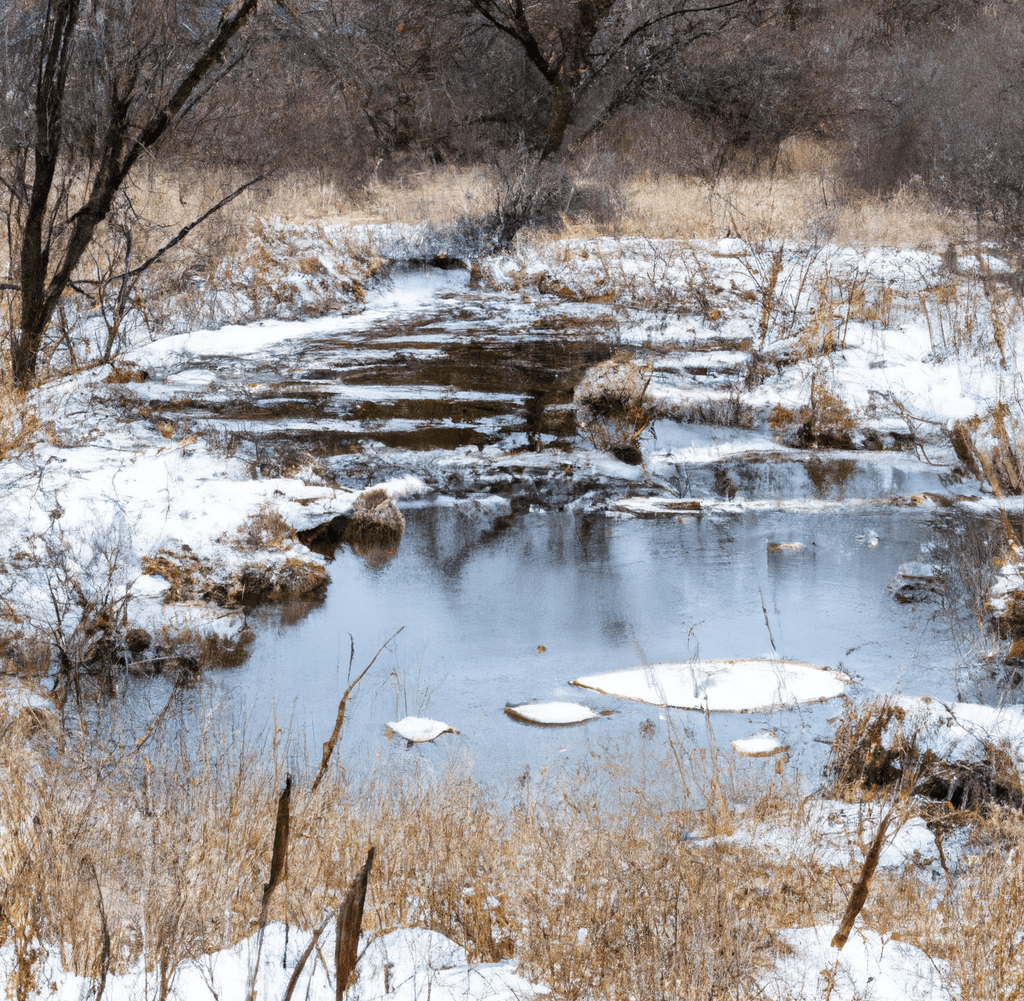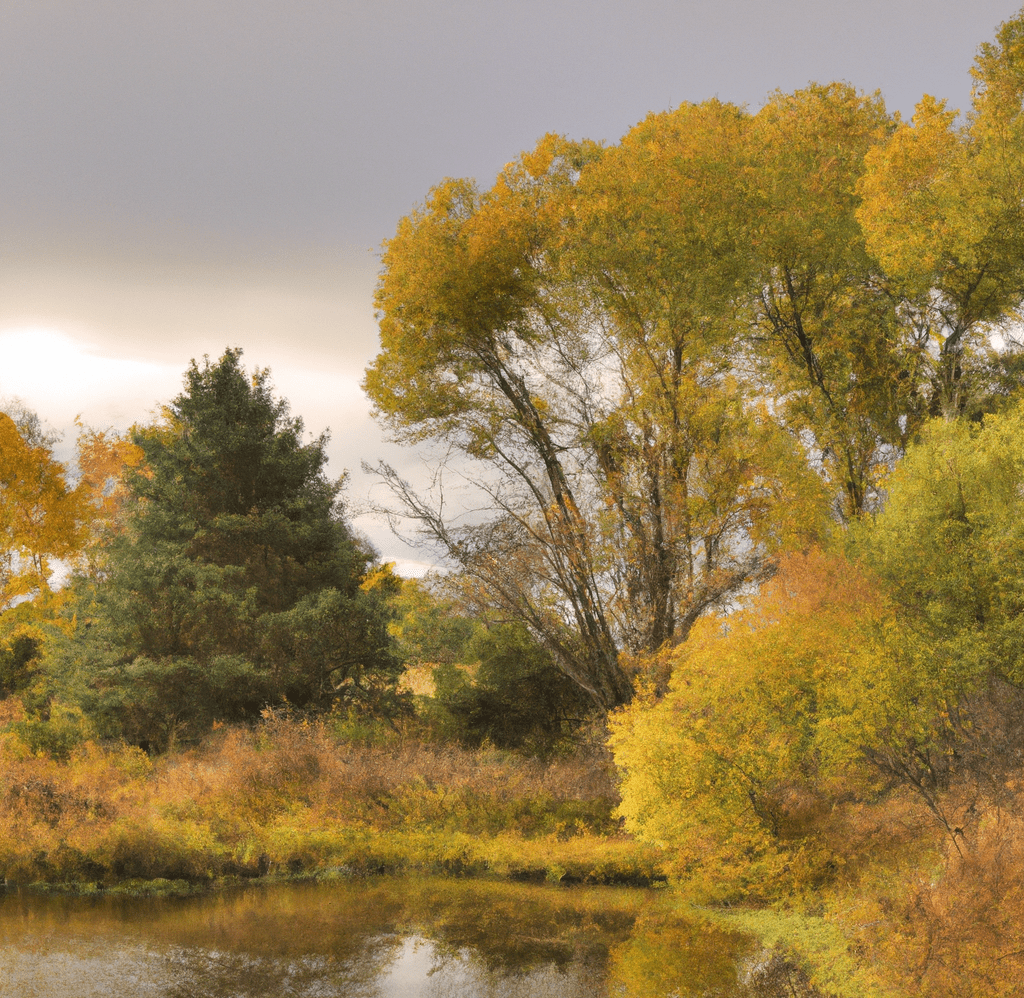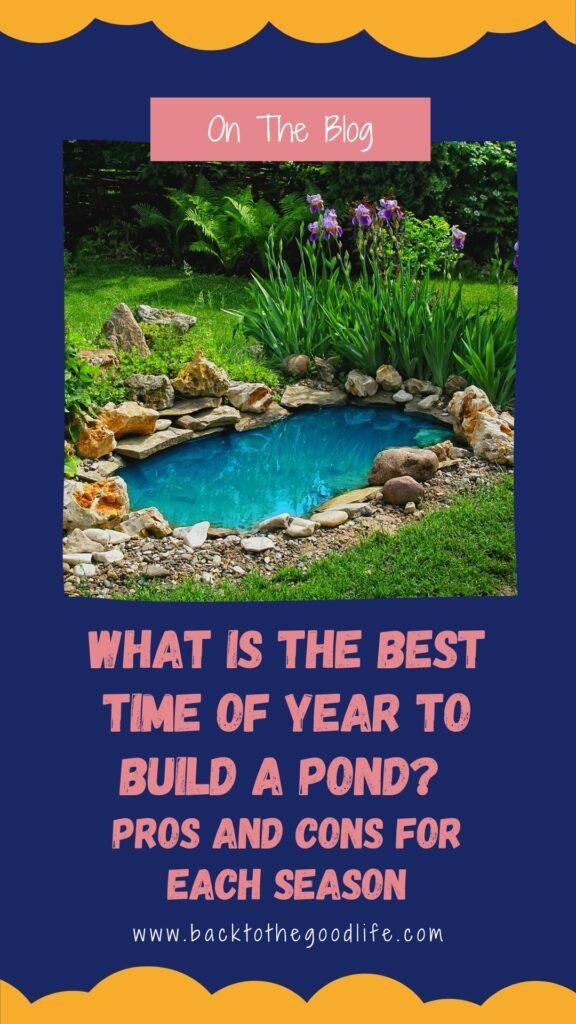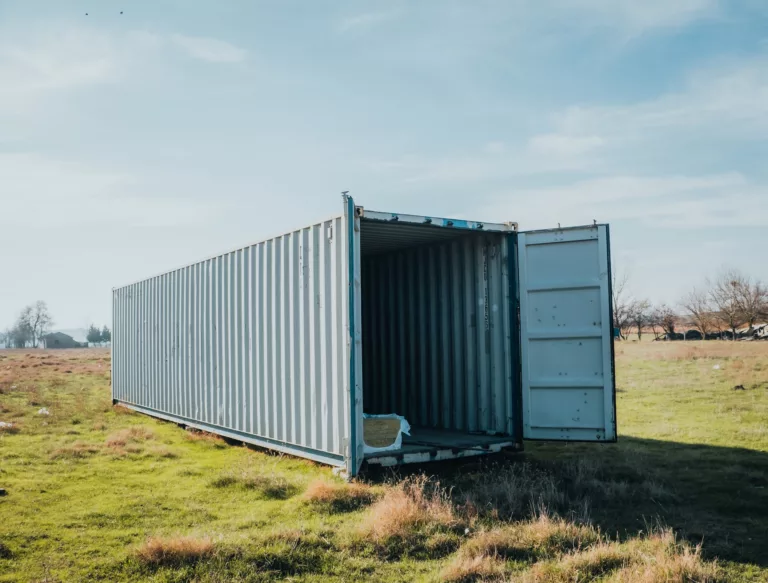The Best Time to Build a Pond: A Seasonal Guide
Just a heads up, this post contains some affiliate links. That means that we earn a small commission if you buy the product at no extra cost to you. That allows us to continue to research and share interesting articles with you. :)
A pond can be a beautiful addition to any garden or yard and can provide a place for fish, amphibians, and reptiles to thrive.

The best time of year to build a pond depends on the climate in your area. If you live in an area with a warm climate, you can build a pond at any time of the year, with the cooler ends of the year being preferable. If you live in an area with a colder climate, it’s best to build a pond in the spring or summer so that the pond has enough time to settle before the winter.
In the UK, either Spring or Autumn is usually the most advisable season to build a pond. Building a pond in early autumn is usually cheaper and better for settling plants and animals in, but you will need to wait until spring for your pond to really get going and reach full maturation.
Why Build A Pond?
There are many reasons why you might want to build a pond. Maybe you’re looking for a way to add beauty and interest to your property. Maybe you’d like to attract wildlife or create a place for swimming, fishing or relaxing.
Whatever your reasons, there are a few things to consider before you get started; most of all: when are you planning to build your pond?
Here are a few pros and cons for each season and what you need to know to make your decision.
Build A Pond In Winter: Pros And Cons
Winter may seem like an unlikely time to build a pond, but there are actually several advantages to starting a pond project when the temperatures drop.
A winter pond can be a beautiful and serene addition to your home. Here are some pros and cons to consider when you’re thinking about whether or not to build a pond in winter,
Pros

- Predictable weather – Although cold, the weather is generally more predictable in winter so that you can plan your build accordingly.
- Cheaper building costs – Winter ponds tend to be less expensive to build than summer ponds; garden centres and landscaping companies face a slow period in winter, which could help you get a cheaper deal on materials and labour costs.
- A full season of growth – You will have the opportunity to see your pond transform from a blank canvas to a fully-fledged ecosystem throughout the following seasons – it can be truly magical to watch!
- Fewer invasive plants – Colder temperatures will help to kill off unwanted plants and algae before they have a chance to take hold.
- You get a great start – The winter months will allow you to take advantage of the natural habitat that your pond will form naturally, rather than creating one from scratch.
Cons
Of course, a few drawbacks to building a pond in winter also exist.
- Harder for plants to thrive – It can be more challenging to find plants that thrive in colder temperatures.
- Freezing water can damage the liner – The cold weather can cause cracks in the liner or other materials, leading to water seeping out and damaging your property. Solid pond liners are usually better at handling this problem.
- Frozen ground – Digging out your pond when the ground is typically frozen solid will be hard work.
- Dormant plants – Any plant life you want to put in the pond will be dormant and not growing; while this is good for moving and bedding in plants, it may take months before your pond is in full bloom.
- Difficult pH level – Cooler temperatures can make it difficult to maintain proper pH levels in your pond, this can be really detrimental to plants, animals, and fish.
Build A Pond In Spring: Pros And Cons
Springtime is another excellent time to consider taking on the challenge to build a pond
Pros
Building a pond in spring has several advantages.
One important question to ask when planning to build a pond is what time of year is best to do so. There are pros and cons for each season, so it is important to weigh these before making a decision.
- Milder weather – The weather is typically milder, making it easier and less time-consuming to dig the hole for the pond.
- Better for bedding plants – The plants that will be placed around the pond will also have an easier time taking root in springtime.
- Longer days – The weather is warm, and the days are long, so you can spend more time outside working on your pond.
- A head start on growing – Warmer and milder weather makes it easier for plants and fish to survive in the early stages of growth.
- A full year to enjoy your pond – if you build a pond in spring, you’ll watch it grow and thrive through spring and summer, and it will be settled and ready for the quiet winter.
Cons
However, if you decide to build a pond in spring, you need to be aware that there are also some disadvantages.
- Spring rains can be unpredictable – If there is significant rainfall, it can delay construction.
- It’s a busy period – Booking in a relatively small pond build with a landscaping company could be problematic if they are busy with other projects.
- Freezing temperatures are still a risk – If you live in an area with cold winters, it’s crucial to ensure the pond can withstand freezing temperatures.
- Plants an animals still need time to acclimatise – Some plants and animals cannot tolerate cold water, so it’s important to research which ones will do well in your climate.
Build A Pond In Summer: Pros And Cons
A pond can be a great addition to your summer landscape. It adds a focal point and can provide a cool, refreshing spot to relax on hot days. Ponds can also attract wildlife, including birds, frogs and essential pollinators like butterflies and bees.
If you’re thinking of adding a pond to your garden or yard, there are a few things to consider.
Pros

Building a pond in the summer has its perks, let’s take a look at a few of the pros.
- Longer days and warmer weather – The warmer weather makes it easier to work outside and the longer days mean you have more time to get the job done.
- Better weather for plants and fish – Warmer weather and more sunshine make it much easier for fish and plants to settle in
- Easier to visualise – Planting plants that are already in bloom will give you immediate feedback when it comes to the look of your landscaping.
Cons
While summer may sound like the best season to build a pond, these downsides do need to be considered,
- The water may get too hot too quickly – Hotter temperatures can also make it harder to keep your pond cool enough for fish and other aquatic creatures.
- Soaring temperatures – The heat can be unbearable, making it difficult to work outside for long periods of time. In the UK, our average summer temperatures from June to September hover around 9–18 degrees Celsius (48–64 degrees Fahrenheit), but recent years have seen summer heatwaves reaching temperatures of around 40 degrees Celcius (104 F).
- Water evapouration – Evaporation is much higher during the summer months, so you will need to replenish your pond more frequently
- Higher risk of algae growth – Algae growth is also accelerated in warmer water temperatures, so you will need to be extra vigilant about keeping your pond clean.
Build A Pond In Autumn: Pros And Cons
As the leaves begin to change colour and fall gently to the ground, you may find yourself with an urge to build a pond.
Although it may seem like building a pond in autumn would be more difficult than spring or summer, it can be quite simple. Here are a few pros and cons to consider if you decide to build a pond in autumn.
Pros
We believe that autumn is the best season to build a pond. Here are a few of the reasons why.

- Working outside is easier – The weather is cooler, making it more comfortable to work outside.
- Incredible scenery – The autumnal colours can be stunning against the backdrop of a pond.
- Plenty of time to settle in – You can spend that time watching your pond settle into it’s landscape and the wildlife to find it naturally.
- Fish have an easier time settling in – The cooler weather is easier on the fish and they are less likely to get sick when you move them in.
- Less algae growth – The water tends to be clearer in autumn thanks to cooler temperatures killing off algae, so you can see the fish and plants more easily.
- Easier building conditions – The ground is not as wet as it is in winter and spring, or as hard as it is in summer making it easier to dig, and there is also less chance of flooding.
Cons
There are a few downsides to consider when building a pond in autumn, though.
- Cooler water temperatures – Towards the end of autumn, the water will be colder, so make sure your plants are hardy enough to survive in cooler temperatures.
- The days get rapidly shorter – You’ll also want to take into account the shorter days and plan accordingly so you have enough time to finish before it gets too dark.
- Unpredictable weather – Autumn weather is notoriously unpredictable. While your weather app may say it will be sunny and warm on the Saturday you’ve planned to build a pond in your garden, be prepared for that to change overnight and necessitate a change of plans.
Overall, building a pond in autumn can be a great experience if you’re prepared for the challenges that come with it.
Related Questions
Building a pond is an exciting project to undertake, but there are plenty of questions that can make the task seem very daunting. Here are a few of the frequently asked build a poond questions we see.
Where Is The Best Place To Build A Pond?
There are many factors to consider when choosing the best location to build a pond. The first step is to select a level spot on your property that receives at least six hours of direct sunlight each day. Once you’ve found the perfect spot, it’s time to start excavating!
The depth of your pond will depend on the type of fish you plan on stocking it with. A general rule of thumb is to make the pond at least two feet deep. This will ensure that your fish have enough room to swim and thrive.

When it comes to the size of your pond, there is no such thing as too big! The larger the pond, the more wildlife it will attract. Plus, you’ll have plenty of room to add features like a waterfall or fountain.
An above ground pond is a great way to add a pond to your garden if you have a solid base like a patio or concrete. Some even come with little round windows to allow you to watch your fish swimming around!
In some cases, you can combine a pond with a swimming pool to make a gorgeous natural poolfor both humans and wildlife to enjoy. These pools do take some maintenance, but if you’ve always wanted a swimming pool in your garden but don’t like the environmental impact of the chemicals, this is the perfect option for you.
Fun fact: both ponds and swimming pools rarely require planning permission in the UK! Check out this blog for the full details.
Should I Build A Pond In The Sun Or Shade?
When deciding if you should build a pond in the sun or shade, you should consider a few things. What kind of plants and animals do you want to put in your pond?
If you want to put fish in your pond, you’ll need to ensure it’s in the sun, so the water doesn’t get too cold. Plants also need sunlight to grow, so if you want a lot of plants in your pond, putting it in the sun is the way to go.
However, if you don’t want any plants or fish in your pond, then putting it in the shade might be best, so the water doesn’t get too hot.
Another thing to consider is how much maintenance you’re willing to do. Ponds in the sun will require more maintenance than ponds built in the shade because algae will grow more quickly in warmer water.
How Deep Should A Pond Be?
When you are planning to build a pond, one of the first things you need to consider is how deep it should be. There are a few factors that will affect the depth of your pond, including the climate, the type of fish you plan to keep, and the plants you want to grow.
In general, ponds should be at least three feet deep. This depth will allow for adequate circulation and filtration, and will also provide enough water for most fish and plants. If you live in an area with a warm climate, you may need to make your pond even deeper to prevent the water from becoming too hot.
If you plan to keep large fish in your pond, such as koi or goldfish, you will need to make sure it is deep enough for them to swim comfortably.
How Long Does A New Pond Take To Settle?
In general, it takes a new pond about 6-8 weeks to settle. This is due to the fact that ponds are constantly changing ecosystems, with new plants and animals continually entering the water. During this time, the pond will go through a natural process of maturation as the bacteria and other microorganisms establish themselves in the water.
The pond will reach a point where the number of new organisms entering the water is balanced by the number of organisms leaving the water, at which point it will be considered settled. The water quality will slowly improve as the pond matures and becomes more balanced.
Building a pond can be a lengthy process, especially if you’re starting from scratch. It can take anywhere from weeks to months for a new pond to settle and become fully operational.

Here’s a breakdown of what you can expect when building a pond:
- Excavation: This is the first step in building a pond and can take anywhere from days to weeks, depending on the size and depth of your pond.
- Liner installation: Once the excavation is complete, the liner must be installed. This process typically takes 1-2 days.
- Fill: The third step is to fill your pond with water. This can take several days, depending on the size of your pond and the available water source. It’s best to fill any pond with harvested rainwater rather than tap water or municipal water. If you only have access to tap water, you may need to treat it with the right additives before you can add plants or animals to your pond.
- Plants and animals: The fourth step is to add plants and animals to your new pond. Depending on the season, these plants and animals could take anywhere from a couple of weeks to settle in up to a couple of months.
Back To The Good Life is a participant in the Amazon Services LLC Associates Program, an affiliate advertising program designed to provide a means for sites to earn advertising fees by advertising and linking to Amazon.com. We also participate in other affiliate programs which compensate us for referring traffic.







